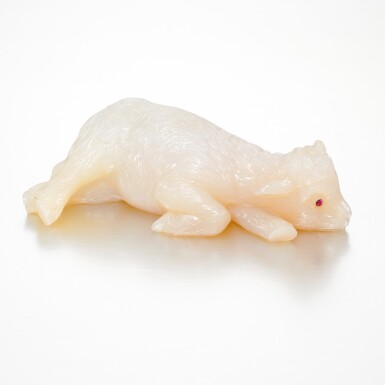
Property from the Brooklyn Museum, sold to Support Museum Collections
AN EXCEPTIONAL FABERGÉ JEWELLED CHALCEDONY MODEL OF A BILLY GOAT, ST PETERSBURG, CIRCA 1900
Auction Closed
December 2, 11:54 AM GMT
Estimate
50,000 - 70,000 GBP
Lot Details
Description
Property from the Brooklyn Museum, sold to Support Museum Collections
AN EXCEPTIONAL FABERGÉ JEWELLED CHALCEDONY MODEL OF A BILLY GOAT, ST PETERSBURG, CIRCA 1900
Realistically carved in pale pink chalcedony as a resting billy goat kid, with legs folded beneath, cabochon ruby-set eyes, apparently unmarked; in its original silk and velvet lined fitted Fabergé hollywood case stamped with the Imperial warrant St Petersburg, Moscow
length 5cm, 2in.
Helen Babbott Sanders
The Brooklyn Museum, New York, bequest from the above in 1983
New York, Fabergé: Exhibition for theBenefit of the Scholarship Fund of the Cooper-Hewitt Museum, the Smithsonian Institution's National Museum of Design, New York, A La Vieille Russie, Inc., 1983
New York, A La Vieille Russie, Inc., Fabergé, April 20 - June 4, 1983
Munich, Kunsthalle der Hypo-Kulturstiftung, Fabergé: Hofjuwelier der Zaren, December 5, 1986 - February 22, 1987
Houston, Museum of Natural Science, The World of Fabergé: Russian Gems and Jewels, February 11, 1994 - July 10, 1994
New York, Brooklyn Museum of Art, BMA Fabergé Installation, supplementary to Jewels of the Romanovs: Treasures of the Russian Imperial Court, March 20 - July 12, 1998
San Francisco, M.H. de Young Memorial Museum, Fabergé in America: the Legacy of the Tsars, May 25 - July 28, 1996; also travelled to New York, Metropolitan Museum of Art, February 12 - April 30, 1996; Richmond, Virginia Museum of Fine Arts, August 24 - November 9, 1996; New Orleans, Fine Arts Museum, December 7, 1996 - February 8, 1997; and Cleveland Museum of Art, March 12 - May 11, 1997
Baltimore, Walters Art Museum, The Fabergé Menagerie, February 13 - July 27, 2003; also travelled to Columbus, Columbus Museum of Art, October 12, 2003 - January 4, 2004; Portland, Portland Art Museum, February 8 - May 2, 2004
G. von Habsburg, Fabergé - Hofjuwelier der Zaren, Kunsthalle der Hypo-Kulturstiftung, Munich, 1986, n. 358, p. 203 illustrated
G. von Habsburg and D. Park Curry, Fabergé in America, San Francisco, 1996, n. 182, p. 199 illustrated
Exhibition catalogue The Fabergé Menagerie, Walters Art Museum, Baltimore, 2003, n. 85, p. 151 illustrated
Fabergé animals are among the most whimsical and imaginative objects of vertu made by the famous firm, whose Royal and Imperial clients often favoured animal and flower studies (see lots 9 and 10) to elaborate jewels. The present model of a billy goat kid is the only known Fabergé carving of its kind.
These works, employing a range of natural materials, creatively and expertly transformed into realistic life studies were so popular amongst Faberge’s elite clientele that Queen Alexandra’s birthday table was described by Viscount Knutsford as containing numerous animals, which were augmented by further examples as she received her birthday gifts in 1909. These animals formed part of the Sandringham commission that is now part of the Royal Collection and represents the largest collection of hardstone animal models (C. de Guitaut, Fabergé’s Animals, A Royal Farm in Miniature, p. 9).
The Sandringham commission tells us much about the intricate process involved in creating each, individual Fabergé hardstone animal. The commission was born out of the Royal Family’s constant demand for new and interesting animal figures paired with the appetite of Fabergé’s other clients for these playful objects. In the case of the Sandringham commission, each animal was observed first-hand to create a wax model that was then executed in Russia by Fabergé’s ‘sculptor-stonecarvers’, famed for their ability to source the appropriate hardstone to capture the natural aspects of the animal. The careful choice of stone is described in the memoirs of one of the firm's head workmasters Franz Birbaum, written in 1919:
‘It is impossible to list all the animals that were used as themes for these figures, but it should be said that the pose was always as compact as possible, as dictated by the technique of the material.’ ('Birbaum Memoirs' in G. von Habsburg, M. Lopato, Fabergé: Imperial Jeweller, Milan, 1993, p. 459)
The workshops in which these animals were sculpted were most likely those of Kremlev and Derbyshev, who both carved studies themselves and oversaw the complete production process of each work. Thoughtful sculptures employing the vast range of naturally occurring Russian minerals came increasingly to the fore of Fabergé’s production, causing it to increasingly focus on hardstone animals, flowers and figures (C. de Guitaut, op. cit., p. 23).
It was of the greatest concern to Fabergé’s craftsmen that the perfect mineral specimens, of the right colour and markings were sourced for each individual study. In the present study of a resting billy goat kid, the subtle luminosity of chalcedony gives the finely carved fur and the perfectly folded legs the sheen of new birth.
Once the carving of each animal was completed, it was returned to the workshop of Fabergé’s head workmaster. In the case of the present studies, most likely that of Michael Perchin or Henrik Wigström. In the workshops the animals were then polished and mounted with their finishing touches, such as their gem-set eyes. These works were then retailed though Fabergé’s shops in St Petersburg and London, where they were broadly collected. Notably, an inventory of the possessions of Empress Maria Feodorovna and Emperor Alexander III compiled by the director of the Anichkov Palace after 1917 lists more than one hundred Fabergé stone animal studies (C. de Guitaut, op. cit., p. 34).
Intrinsically charming and representative of the highest level of craftsmanship, the animals in the present collection have many corollaries in the Royal Collection, but this billy goat kid appears to be without parallel. While models of a ram (RCIN 4044) from the Sandringham commission and a model of an adult goat are known, the present sculpture of a billy goat appears to be unique.
